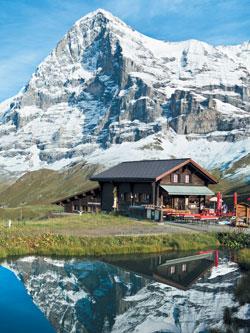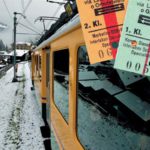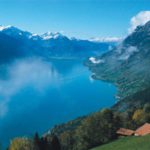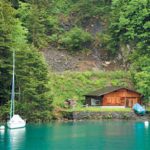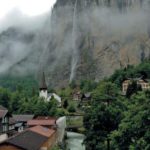Majestic scenery and hearty food make Switzerland a mustsee destination
RICHARD HOLMES
The diminutive Asterix may have been from an indomitable village in Gaul, but – on a cold night in Switzerland – I find it hard not to think of the moustachioed hero as I dunk my skewer of yeasty rye bread into the fondue pot of bubbling cheese at Restaurant Laterne.
When Asterix and the ever-faithful Obelix “visited” Switzerland they were quickly warned about the strict rules of fondue: “Everyone got it? If you lose your piece of bread in the fondue, you pay a forfeit! The first time it’s five of the best with a stick; the second time you get 20 lashes with a whip; the third time you get thrown into the lake with weights tied to your feet!”
Given that we were enjoying our fondue in the Alpine town of Interlaken – “between lakes” – there was no shortage of water if I lost my third piece of rye. The glacial waters of Lake Brienz, just down the road, are the deepest in Switzerland and I was in no mood for a dip. So, despite the warm welcome we’d received, I wondered whether another glass of schnapps was really a good idea? “But you must have the schnapps with it!” exclaimed our host Daniela. “The alcohol of the schnapps cuts through the heavy cheese and makes you feel light inside. You just dip the bread – quickly – into the apple schnapps, then into the cheese, then pop it in your mouth.”
As a glass of fiery schnapps found a home in front of me it was hard to refuse. Platters of raclette – grilled cheese served simply with a bag of steaming new potatoes – arrived to fill the gaps left behind by the cheese fondue, with plates of rosti in hot pursuit. Done the traditional way, potato and onion are roughly chopped and fried, then served with bacon, sausages and a creamy mushroom sauce.
It is this hearty Swiss food cooked in the time-honoured way that brings adventurous tourists away from Interlaken’s main drag and through the heavy wooden doors of this cosy eatery. Locals bustled in and out, tucking into cheesy fondue and farm bread, washed down with a glass or three of Rugenbräu, a crisp local beer that’s as good as schnapps for lightening the load. This is no place for travellers on a diet, but after a long chilly day in the Alps the dishes of rib-sticking fondue and raclette were just what my stomach was grumbling for.
And it is, after all, days of high-altitude adventure that bring most visitors to this part of the world. Just a few hours from Zurich on Switzerland’s ridiculously good rail network, Interlaken is the gateway to the world-famous Jungfrau railway that is (apart from the fondue) the highlight of any trip to this corner of the Swiss Alps. It’s usually only ski visitors and alpine climbers who get to enjoy the best of Switzerland’s lofty peaks, but the Jungfrau railway whisks day-trippers up to what is officially – and constantly – hailed as the highest station in Europe.
At 3 500-metres above sea level, it doesn’t take long for your lungs to realise that something is amiss. Oxygen. But that shortness of breath could also be due to the gasps of delight as the Swiss mountain scenery unfolds alongside the cogwheel track. A track where, even in summer, snow can blanket the mountainside below the three high peaks – Eiger, Mönch and Jungfrau – which tower over Interlaken.
While the railway is an incredible feat of engineering, it is the dramatic scenery that entrances all but the most anorak-clad of train-spotters. Dozens of cascades around the village of Lauter Brunnen cover the cliffs in spray, while the ski runs of Wengen are quiet out of season. Hiking is a popular activity for the months when the hills are green and alive with spring flowers.
The railway then burrows through the solid rock of the Eiger’s infamous north face to emerge at the dramatic Jungfrau observation deck, clinging to a rocky outcrop atop the Eiger glacier. If the weather plays ball, the ice-covered valleys fall away on all sides as the craggy peaks of the Alps guard the border with Italy.
It might be the roof of Europe, but there’s no hardship for Jungfrau travellers. Even on the summit a range of restaurants cater for the 650 000 annual visitors, with Restaurant Crystal’s selection of Swiss specialities certainly your best bet. Railways and ski lifts criss-cross the lower slopes of the Jungfrau, so we take a circuitous route back to Interlaken, meandering sleepily down through the villages of Brandegg and Grindelwald. Wood piles are stacked to dry before winter outside of chalets that seem lifted from the pages of a Heidi cartoon. Cows graze lazily in the fields, their bells sending a deep tinkle across the valleys. As we descend, the glaciers turn into powdery snowfields that melt into rivers, rushing down to fill the deep lakes that surround Interlaken.
By the time we stroll out of Interlaken station, my stomach is rumbling long before we’re due for dinner. Nothing a quick meander into the back streets behind my hotel can’t solve, as I unearth the delightful Reinle Bäckerei with its baskets of knotted bread and bountiful confectionery counter. This is the German-speaking corner of Switzerland, so I wander out munching happily on a tart apfel strudel.
The strudel keeps me company as I walk past pavement cafés on the pedestrian-friendly lanes off the main drag. Interlaken has a love affair with package tourists and the main Höheweg throngs with Asian visitors who keep the multitude of watch and chocolate shops in business. There’s even a chocolate shop called Tourist, in case its clientele was ever in doubt. But wander away from the crowds and Interlaken shows off its charming corners. Locals gather for a coffee and cake at the tiny Bäckerei am Markplatz, where cocoa-dusted truffles and beautiful chocolate cakes line the shelves.
I take a few truffles for the road and wander along the treelined riverfront, where the fishermen won’t let a little drizzle keep them from their rods. An historic weir funnels the River Aare as it flows into Lake Thun. The cableway to Harder Kulm offers wonderful valley views on sunnier days, but in the strengthening drizzle I head for the shelter of the 700-year-old Schlosskirche with its leery gargoyles and rough-hewn walls. The Schlosskirche offers some of the finest High Gothic architecture in the canton of Bern, but this brooding church has also seen humble days as a granary and wine cellar. Whether you’re escaping the rain or the tour-buses, it’s a refuge worth a visit for its impressive stained-glass windows alone. I hurry back to our hotel, a high-rise
By the time we stroll out of Interlaken station, my stomach is rumbling long before we’re due for dinner. Nothing a quick meander into the back streets behind my hotel can’t solve, as I unearth the delightful Reinle Bäckerei with its baskets of knotted bread and bountiful confectionery counter. This is beast that does the local skyline no favours, but offers great mountain views from its fine dining restaurant Top o’Met. The German influence tramps cross the menu with the likes of rosti, sauerkraut and asparagus gratin. It’s a spot where floorto- ceiling views trump charm, but is worth a visit for at least an evening drink before dinner at the lovely Laterne.
There is plenty more to see in and around Interlaken, but – as always – I’m running out of time. The next day, two trains whisk me back to Zurich while – in an impressive display of Swiss efficiency – my luggage is checked in at the railway station to meet me back in Johannesburg.
The Golden Pass Line whisks us past Lake Brienz and on to Luzerne, for a fleeting look at the historic Chapel Bridge. A warm pretzel covered in crunchy salt takes care of the railway munchies as the Pre-Alpine Express – our last stretch on the rails to Zurich – rolls through the gentle landscape of Appenzellerland. The lakes lose their glacial blue, and the deep sing-song of the conductors lulls me to sleep as they “Guten tag… karte” their way down the carriage.
A boat across Zurichsee is the last leg of our journey home, with the deep waters sloshing against the bow as the dome of Grossmunster emerges from the mist. I’ve made my usual mistake of not leaving enough time to properly explore the financial heart of Switzerland, but the wealthy streets flanking the Limmat River will be here for next time. It’s a mistake I can live with. I’m just glad that I didn’t drop any bread in the fondue.
Travel tips
- Getting there: Swiss International Air Lines, boasting arevamped business class cabin, flies daily from Johannesburg to Zurich. Visit www.swiss.com, or call 0860 04 05 06.
- Getting around: From Zurich airport the excellent Swiss railway system is your best way to get around. If you plan on doing a lot of travelling a Swiss Pass will save you money. Visit www.sbb.ch. For more on the Jungfrau railway, visit www.jungfrau.ch.
- Plan your trip: www.myswitzerland.com is the official website of the Swiss National Tourist Office.
SOURCES
RICHARD HOLMES

